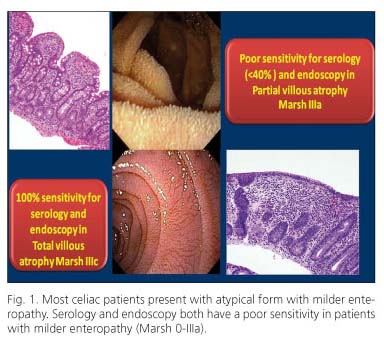Meu SciELO
Serviços Personalizados
Journal
Artigo
Indicadores
-
 Citado por SciELO
Citado por SciELO -
 Acessos
Acessos
Links relacionados
-
 Citado por Google
Citado por Google -
 Similares em
SciELO
Similares em
SciELO -
 Similares em Google
Similares em Google
Compartilhar
Revista Española de Enfermedades Digestivas
versão impressa ISSN 1130-0108
Rev. esp. enferm. dig. vol.104 no.6 Madrid Jun. 2012
https://dx.doi.org/10.4321/S1130-01082012000600013
LETTERS TO THE EDITOR
Avoiding biopsy in iron deficiency anemia is not a cost-effective approach
Evitar la biopsia en la anemia sideropénica no es coste-efectivo
Key words: Coeliac disease. Anaemia. Serology. Histology. Diagnosis.
Palabras clave: La enfermedad celíaca. La anemia. Serología. Histología. Diagnóstico.
Dear Editor,
Disappointingly, the recently published iron deficiency anemia (IDA) guidelines (1) fail to take into account the strong data on seronegative (2-4) celiac disease (CD) and end up in inappropriate advice. According to several studies the prevalence of seronegative patients is much higher than that reported in these guidelines, and it is well known that relying only on antibody testing, even the most sensitive and specific tests can miss at least one in 5 celiac patients. Thus, taking biopsy samples only from antibody positive individuals goes against the evidence behind pitfalls in screening for CD (2-5). Serology and histology could also be negative, patchy, mild, and even normal.
The study this guideline bases the judgment on is poor and non representative, and far from the true prevalence of IDA in CD. In the real world, taking into account the proportion of those cases with negative serology there should be a much higher association between CD and IDA (6). We already know that serology is mainly positive and correlated with severe mucosal abnormalities (2) (Fig. 1) and that most cases present with mild mucosal changes and less antibodies. However, milder enteropathy does not mean less symptoms, as malabsorption is an inflammatory process and does not correlate with mucosal abnormalities at all (7,8). This is the reason why there are over 500.000 undiagnosed celiac patients in the United Kingdom. Avoiding the biopsy in anemic patients who will have gastroscopy as a part of diagnostic work up is not cost effective and may lead to serious delay in diagnosis of seronegative CD patients (8), impair their life quality, and lead to more expensive tests repeating in a vicious circle of ignorance.
Sauid Ishaq1, Rizwan Mahmood1, Vicenzo Vilannacci2, Gabrio Bassotti3 and Kamran Rostami1,4
1Dudley Group of Hospital NHS Foundation Trust. United Kingdom, 2Department of Pathology. Spedali Civili. Brescia, Italy.
3Gastroenterology and Hepatology Section. Department of Clinical and Experimental Medicine. University of Perugia. Italy.
4School of Medicine. University of Birmingham. United Kingdom
References
1. Goddard AF, James MW, McIntyre AS, Scott BB; British Society of Gastroenterology. Guidelines for the management of iron deficiency anaemia. Gut 2011;60:1309-16. [ Links ]
2. Rostami K, Kerckhaert J, Tiemessen R, von Blomberg BM, Meijer JW, Mulder CJ. Sensitivity of antiendomysium and antigliadin antibodies in untreated celiac disease: disappointing in clinical practice. Am J Gastroenterol 1999;94:888-94. [ Links ]
3. Dickey W, Hughes DF, McMillan SA. Reliance on serum endomysial antibody testing underestimates the true prevalence of coeliac disease by one fifth. Scand J Gastroenterol 2000;35:181-3. [ Links ]
4. Sanders DS, Hurlstone DP, McAlindon ME, Hadjivassiliou M, Cross SS, Wild G, et al. Antibody negative coeliac disease presenting in elderly people-an easily missed diagnosis. BMJ 2005;330:775-6. [ Links ]
5. Mulder C, Rostami K, Marsh MN. When is a coeliac a coeliac? Gut 1998;42:594. [ Links ]
6. Harper JW, Holleran SF, Green PH, Bhagat G, Green PH. Anemia in celiac disease is multifactorial in etiology. Am J Hematol 2007;82:996-1000. [ Links ]
7. Rostami K, Al Dulaimi D, Rostami N, et al. Microscopic enteritis and pathomechanism of malabsorption. Autoimmun Highlights 2010;1:37-8. [ Links ]
8. Not T, Ziberna F, Vatta S, Quaglia S, Martelossi S, Villanacci V, et al. Cryptic genetic gluten intolerance revealed by intestinal antitransglutaminase antibodies and response to gluten-free diet. Gut 2011;60:1487-93. [ Links ]















